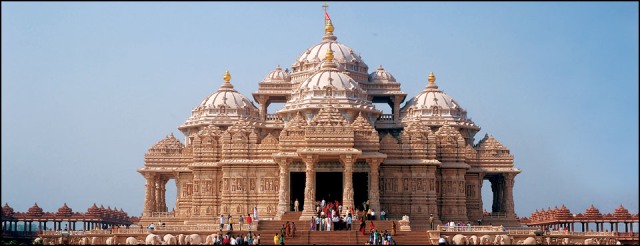Contribute
| South Asian Art History - In Memory Of Prashant H. Fadia |
Ranjani Saigal
10/31/2007
Read the first part of the article
Watch the video.
The front enters features 10 gates symbolizing the 10 directions and seeking good thoughts to come in from all directions. Visitors then encounter the peacock gate that has 869 beautiful peacocks craved on it. Throughout the ages the peacock has been a symbol of beauty and purity.
It is from here that visitors get their first glimpse of the monument itself. Under the central dome is enshrined the Murthi of Shri Swaminarayan and his spiritual successors. Also enshrined are the Murthis of Shri Sita Ram, Shri Radha Krishna, Shri Lakshmi Narayan and Shri Parvathy Mahadev inspiring the eternal Vedic way of worship of Bhakta and Bhagwan.
In the main monument no steel has been used. The design is entirely based on the ancient Indian Sthapathya Shastra. Aksharadam is an amazing revival of Indian stone art and architecture.
The Gajendra Pith is an important part of the monument, which is a 170 ft long plinth of elephants. It features 148 life-like elephants all carefully hand crafted. . Indian tales abound with elephants and many of them are featured on this section.
The majestic monument has 9 magnificent domes, 234 intricately carved pillars, 20 quadrangle-shaped shikhars, 20,000 carvings of great sages, deities, celestial beings, 500 murtis of paramhansas of Bhagwan Swaminarayan and many statues of devotees, birds and animals embellish the inside and outside walls of the monument.
The inside of the monument has 8 ornately carved mandapams, each featuring the forms of Bhagwan Swaminarayan, avatars and the deities of Sanatan Dharma.
The ornate external wall of the Swaminarayan Akshardham monument is known as the Mandovar. In the last 800 years this is the only and largest, intricately carved Mandovar in India with dimensions of 611ft x 31ft. It comprises 200 sculptured stone figures of India’s great rishis, sadhus, devotees, acharyas and divine incarnations.
The Mandovar is made of different layers: Gajstar, Sinhstar, Vyalstar, Kumbhstar, Kalashstar, Gavakshstar, Jangha and Chhajja with a total of 4,287 carved stones. The Kumbhstar includes 48 ornately carved murtis of Shri Ganeshji.
Beautiful bronze relief panels illustrating the divine incidents from the life of Bhagwan Swaminarayan form the core of the Narayan Pith.
From Vedic times India has a glorious tradition of water pilgrim places in the form of rivers, stepwells and lakes. Following this tradition, a sacred water lake, Narayan Sarovar, surrounds the main Akshardham monument. The lake contains holy waters from 151 rivers and lakes sanctified by Bhagwan Swaminarayan, including Mansarovar.
Surrounding the Narayan Sarovar are 108 gaumukhs, symbolizing 108 names of God, from which holy water issues forth. Fully-bloomed lotus flowers in the lake impart an inspiring message of purity and detachment.
From ancient times the parikrama (circumambulatory path) of mandirs are pathways to express reverence and devotion to the deities of Sanatan Dharma.
The Swaminarayan Akshardham parikrama is made of red stone from Rajasthan, consisting of 1,152 pillars, 145 windows and 154 samvaran shikhars; amounting to a total of 53,956 stones. It surrounds Akshardham like a beautiful decorative garland. Every window and gallery in the lower parikrama provides different views and insights to Akshardham monument. You can hear the soothing sound of water issuing from the 108 Gaumukhs. The soft chanting of the holy names of God permeates the parikrama, giving an experience of peace and divinity. The two-tiered parikrama is the first of its kind in India.
From the ancient Stapathya Shastra we move on to the modern art world of animatronics. The Hall of Values exhibits portray the messages of ahimsa, endeavor, prayer, morality, vegetarianism, family harmony, etc. through fifteen 3-D dioramas and presentations from the life of Bhagwan Swaminarayan. Exquisite settings and statues in each diorama are brought to life through robotics, fibre optics, light and sound effects, dialogues and music; transporting the audience to 18th century India.
Using modern technology visitors are treated to a Disney- like 12-minute spectacular boat-ride through which they can experience the 10,000 year old India’s glorious heritage. Visitors can savor the world’s oldest Vedic village life and bazaar or sail through Takshashila – the world’s first university. They can also Journey through the labyrinth of ancient discoveries and inventions by the great rishi-scientists of India
The Yagnapurush Kund is a fascinating combination of a Vedic yagna kund and a musical fountain. It is the world's largest yagna kund measuring 300' X 300' with 2,870 steps and 108 small shrines. In its center lies an 8-petaled lotus shaped yagna kund designed according to the Jayaakhya Samhita of the Panchratra scripture. Its perfect geometric forms testify to ancient India's advanced knowledge in mathematics and geometry. At night the center comes to life with a colorful musical water fountain that echoes the Vedic sentiments of India. Yagnapurush Kund has been so named after the founder of BAPS Swaminarayan Sanstha and the third successor of Bhagwan Swaminarayan, Swami Yagnapurushdasji (Brahmaswarup Shastriji Maharaj). Beautiful gardens surround Akshara Dham.
To see Akshar Dham is to behold a breathtaking wonder. It does overshadow the Taj Mahal in its splendor and shows tourists that the greatest monument in India is the one that pays tribute to life, love and draws from India’s rich cultural heritage.
You may also access this article through our web-site http://www.lokvani.com/
